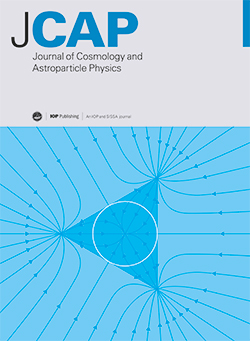Wide binary evaporation by dark solitons: implications from the GAIA catalog
IF 5.3
2区 物理与天体物理
Q1 ASTRONOMY & ASTROPHYSICS
Journal of Cosmology and Astroparticle Physics
Pub Date : 2025-02-04
DOI:10.1088/1475-7516/2025/02/001
引用次数: 0
Abstract
An analytic calculation is given for binary star evaporation under the tidal perturbation from randomly distributed, spatially extended dark objects. In particular, the Milky Way's wide binary star population is susceptible to such disruption from dark matter solitons of comparable and larger sizes. We identify high-probability `halo-like' wide binaries in GAIA EDR3 with separations larger than 0.1 parsec. Survival of the farthest-separated candidates will provide a novel gravitational probe to dark matter in the form of solitons. In the case of dilute axion-like boson stars, the observational sensitivity extends into the axion mass range ma ∼ 10-17 -10-15eV.求助全文
约1分钟内获得全文
求助全文
来源期刊

Journal of Cosmology and Astroparticle Physics
地学天文-天文与天体物理
CiteScore
10.20
自引率
23.40%
发文量
632
审稿时长
1 months
期刊介绍:
Journal of Cosmology and Astroparticle Physics (JCAP) encompasses theoretical, observational and experimental areas as well as computation and simulation. The journal covers the latest developments in the theory of all fundamental interactions and their cosmological implications (e.g. M-theory and cosmology, brane cosmology). JCAP''s coverage also includes topics such as formation, dynamics and clustering of galaxies, pre-galactic star formation, x-ray astronomy, radio astronomy, gravitational lensing, active galactic nuclei, intergalactic and interstellar matter.
 求助内容:
求助内容: 应助结果提醒方式:
应助结果提醒方式:


